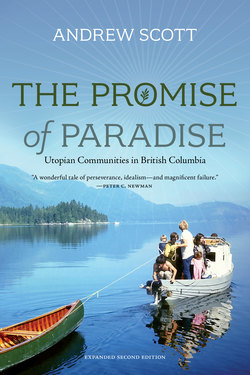Читать книгу The Promise of Paradise - Эндрю Скотт - Страница 8
На сайте Литреса книга снята с продажи.
ОглавлениеPreface to the Second Edition
The first edition of this book was published in 1997, twenty years ago. Much has happened since then. To my knowledge, no other survey or overview of British Columbia’s utopian communities has appeared since 1997, despite the fact that many people remain intensely interested in this subject. Bringing the original book up-to-date seemed a worthwhile project. I have revised and amplified the text, correcting some minor errors and adding several new sections. One concerns the Emissaries of Divine Light, who, considering their importance to intentional community development in BC, did not, I feel, receive adequate coverage in the first edition. A second section describes 1970s countercultural activity on the Sunshine Coast, which Weekend Magazine claimed was “at the vanguard of the Canadian commune movement.”
The most obvious change in intentional communities since 1997 concerns co-housing, which was just getting started at the time of the first edition. At least ten new co-housing complexes have opened, or are about to open, since then. And two refinements on the co-housing theme—senior co-housing and the ecovillage—have started to appear in the province. I have expanded the text accordingly. I was a bit surprised, at first, that more ventures hadn’t come to fruition since 1997. Back then I was predicting that the co-housing movement would catch fire. And so it has. But I failed to take into account how long each project would take to evolve and emerge. By its very nature, co-housing, with its many meetings and its need to forge consensus on every detail, is a slow mover. It would only ever appeal to a small percentage of the population. Despite the seemingly low numbers, BC continues to lead Canada in new co-housing starts.
It was a delight, while revisiting the ephemeral world of intentional communities, to discover that several of the places I had visited and written about twenty years ago are still intact. Quatsino, Hagensborg, Sointula and Argenta, in fact, are flourishing. The Doukhobors, while struggling to retain their culture, remain an exceedingly viable group. Kitsilano’s Community Alternatives Co-op is plugging along, as are the New Westminster Co-op and the Community Enhancement and Economic Development Society (CEEDS), formerly the Ochiltree Organic Commune, near 100 Mile House. The Emissaries, though severely diminished in number, have regrouped and are tenaciously clinging to their remaining strongholds.
As I prepared this second edition, however, it became clear to me that the creation of lasting, egalitarian human communities is an evolutionary process. Intentional communities will always struggle to survive. They are experiments, after all, and some experiments are destined to fail. Groups that endure seem to place a high value on co-operation and equality. Their members often support a consensual approach to decision-making. Successful communities are built on the shoulders and backs of unsuccessful efforts, and only exist because many before them have tried and failed.
